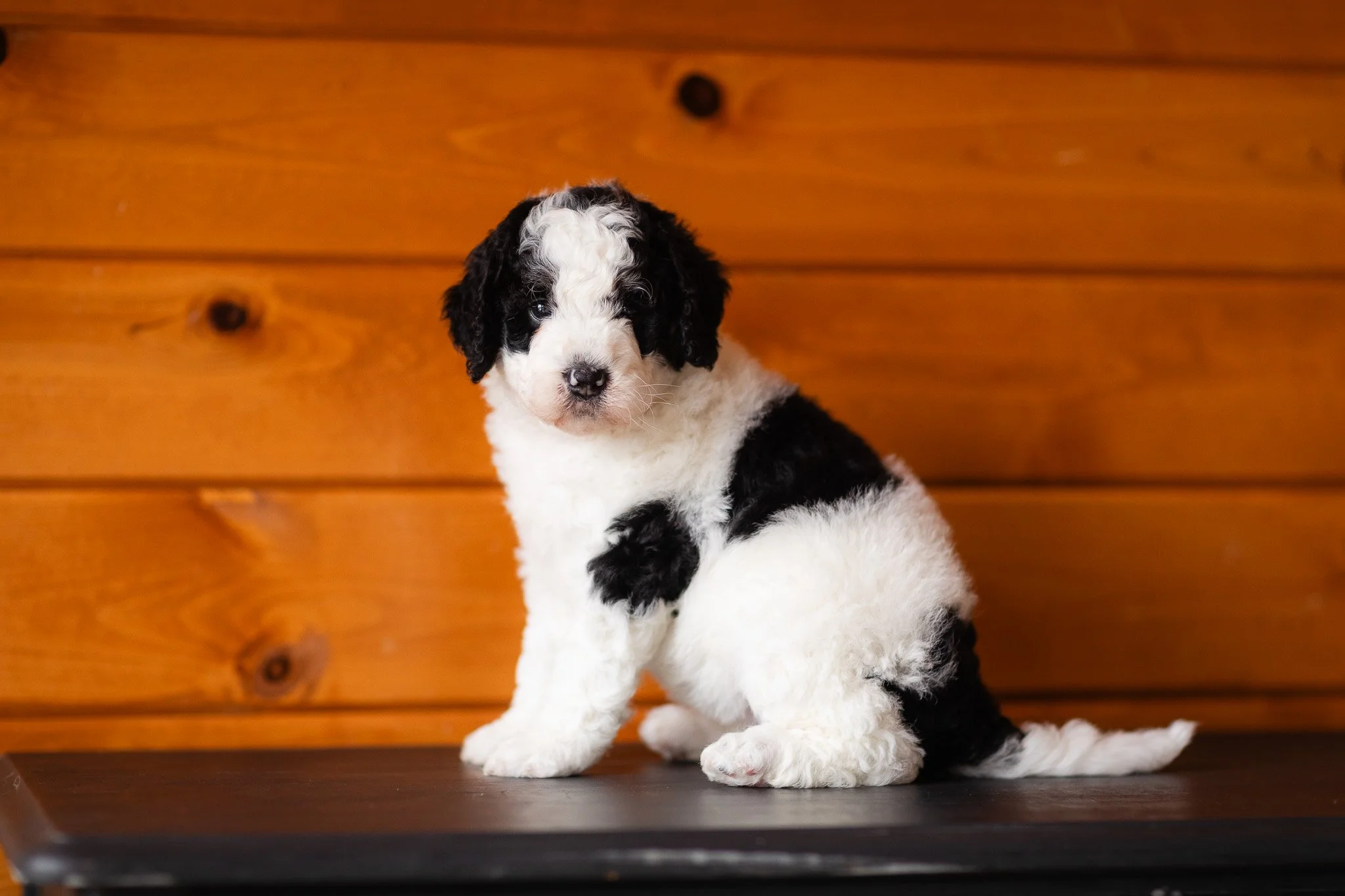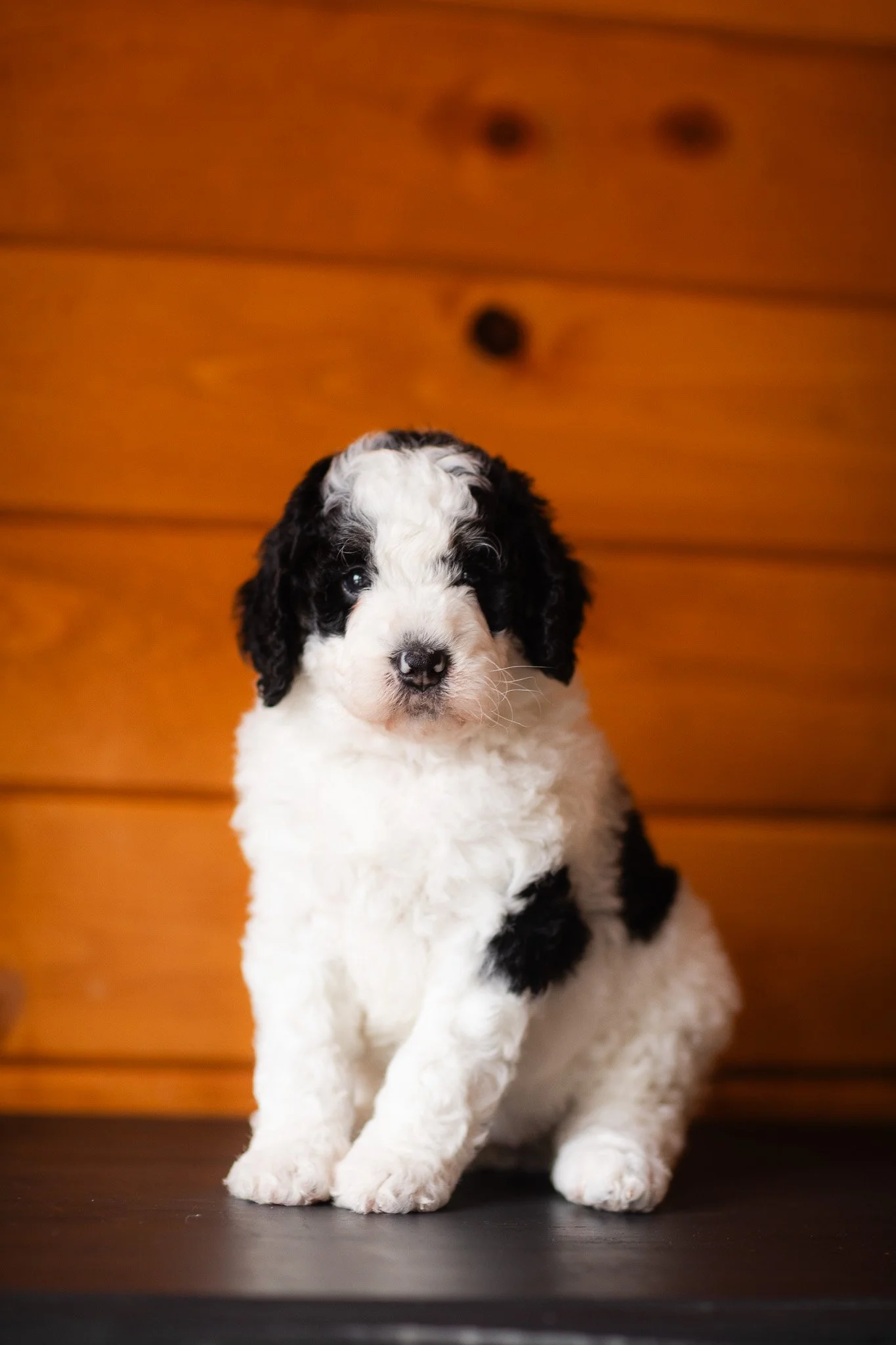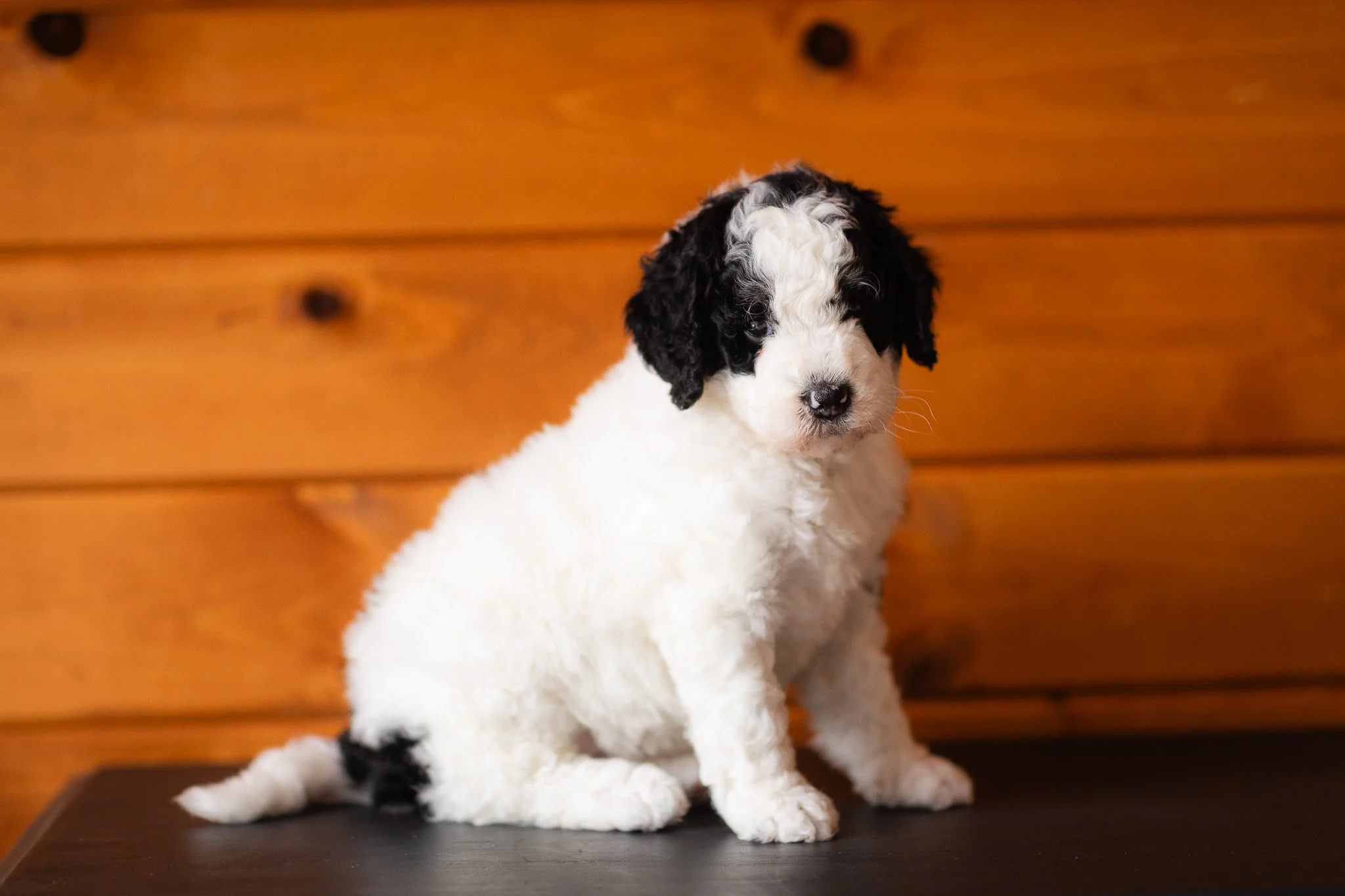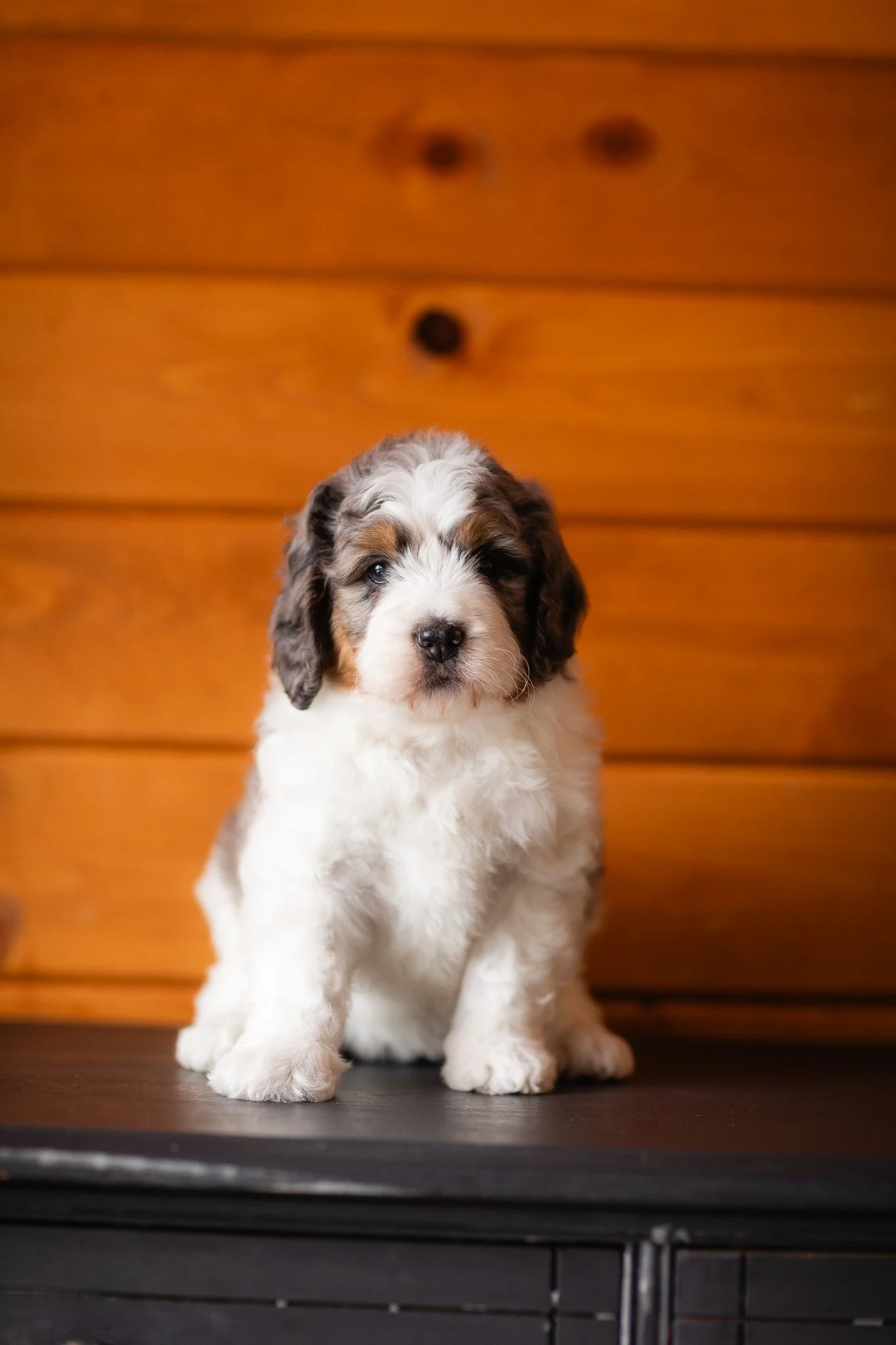What are parti Bernedoodles?
Red Merle Tri, Parti, Blue Merle Tri Tuxedo Berneoodles
Parti Bernedoodles are embraced for their calm demeanor and striking white coat, these dogs are a blend of Poodle and Bernese Mountain Dog and are generally a second generation or multi-generation as the Parti gene does not exist in Bernese Mountain Dogs. Their unique coat boasts a primary white hue with over 50% coverage, overlaid by a secondary color. Parti Bernedoodles come in various hues, including rare shades like red and silver. While young, their coat's blend evolves, solidifying as they mature. Microphthalmia-associated transcription factor (MITF) gene contributes to their color diversity.
What is the Parti Gene?
The Parti gene, also known as the "piebald" gene, is a genetic factor responsible for creating the distinct color pattern seen in "Parti" dogs, including Parti Poodles and Parti Bernedoodles. This gene affects the distribution of pigments in a dog's coat, leading to a predominantly white base with patches of another color. The Parti gene is responsible for the unique coat pattern where the primary color covers less than 50% of the dog's body, and the secondary color is present in larger patches. This gene contributes to the charming and eye-catching appearance of Parti dogs, setting them apart from dogs with solid coat colors.
What dogs come are Parti-Colored?
The piebald gene, which is responsible for the distinctive coat pattern seen in piebald or "Parti" dogs, can be found in various breeds. Some dog breeds that can carry the piebald gene and exhibit Parti coloration include:
Poodles: Parti Poodles are well-known for their piebald coat pattern, with white as the primary color and patches of another color.
Bernedoodles: Parti Bernedoodles, which are a crossbreed between Bernese Mountain Dogs and Poodles, can also exhibit the piebald coat pattern.
Cocker Spaniels: This breed can also have dogs with the piebald gene, resulting in a distinctive coat pattern.
Dachshunds: Piebald Dachshunds have a similar coat pattern, with white as the primary color and patches of another color, often seen in the breed's longhaired variety.
Beagles: Some Beagles can carry the piebald gene, leading to variations in coat color and pattern.
Boxers: Boxers can also exhibit the piebald pattern, with white being the predominant color and patches of another color, typically fawn or brindle.
English Setters: This breed can have dogs with piebald patterns, which contribute to their unique appearance.
It's important to note that the presence of the piebald gene and the expression of the Parti coat pattern can vary within individual breeds. Additionally, while the Parti gene can lead to eye-catching coat patterns, it doesn't affect the dog's overall health or temperament.
What does Sp & Si Mean?
In dog coat color genetics, "Sp" and "Si" are abbreviations for two different alleles (gene variants) that affect coat color.
1. Sp (Piebald or Parti Gene): The "Sp" allele stands for the piebald or parti gene. This gene variant is responsible for creating the piebald or Parti coat pattern, where the dog has a predominantly white base coat with patches of another color. This gene affects the distribution of pigments in the coat and leads to the characteristic two-color or multi-color pattern seen in Parti dogs.
2. Si (Irish Spotting Gene): The "Si" allele stands for the Irish spotting gene. This gene variant is associated with the expression of white spotting or markings on dogs. It can result in various degrees of white on the coat, from small markings (such as a white blaze on the chest or paws) to larger areas of white. The presence of the Irish spotting gene contributes to the white markings often seen on breeds with "flashy" coats.
Both the Sp and Si alleles are examples of genetic factors that influence coat color patterns and white markings in dogs. The presence or absence of these alleles, along with other coat color genes, contributes to the wide variety of coat colors and patterns observed in different dog breeds.
What is Irish Spotting in Bernedoodles?
"Irish spotting" refers to a specific pattern of white markings or spots on a dog's coat. This term is commonly used in genetics and dog breeding to describe the distribution of white color on a dog's body. The Irish spotting pattern is characterized by white markings that typically appear on certain specific areas of the dog's body, often on the muzzle, chest, paws, and tail tip.
Irish spotting can vary in intensity, ranging from small white markings on the toes or chest to larger areas of white that cover a significant portion of the body. Dogs with the Irish spotting pattern may have a mostly colored coat with these distinct white areas, giving them a unique and eye-catching appearance.
The genetic basis for the Irish spotting pattern involves the interaction of various genes that control the distribution of pigments in the coat. The "Si" allele, which stands for the Irish spotting gene, is associated with this pattern. Dogs that carry this allele can exhibit different degrees of white markings, depending on other genetic factors and the specific breed's genetic makeup.
It's important to note that Irish spotting is just one of many coat color patterns and variations found in dogs. Different breeds and individual dogs can show a wide range of coat colors and patterns due to the interplay of various coat color genes.
Bernese Mountain Dogs are known for its distinctive tricolor coat, which features a primarily black coat with rust and white markings. The rust markings typically appear above the eyes, on the cheeks, legs, and on the chest, while white markings are typically present on the chest, paws, and sometimes on the face and tail tip.
Irish Spotting in Poodles
Irish spotting is not a common coat pattern found in Poodles. Poodles are known for their solid-colored coats, and they come in various solid colors such as black, white, apricot, cream, brown, and gray. They can also have variations of these colors, but the coat is typically a single, solid hue.
The term "Irish spotting" usually refers to the presence of white markings on specific areas of the body, such as the chest, muzzle, paws, and tail tip. Poodles, being known for their solid colors, do not typically exhibit this kind of pattern. The breed's coat genetics lean more towards solid colors rather than extensive white markings.
However, in the realm of dog genetics, it's important to acknowledge that there can be occasional variations and surprises due to the complexities of coat color genes. While Irish spotting is not a recognized or typical pattern in Poodles, there could be individual dogs that might show some degree of white markings, but it would be atypical for the breed.









